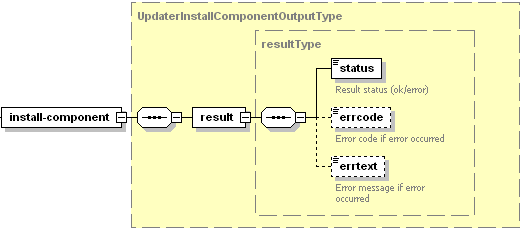Installing Components
The install-component operation is used to install specified components to your Plesk server.
Note: This operation is supported only in Plesk for Unix.
Request Packet Structure
A request XML packet installing Plesk components includes the install-component operation node:
<packet>
<updater>
<install-component>
...
</install-component>
</updater>
</packet>
The graphical representation of the install-component node is as follows:

Note: The interactive schema navigator for all request packets is available here: http://plesk.github.io/api-schemas/1.6.9.1/agent_input.svg.
- The update-id node is required. It specifies the update ID. Data type: string.
- The component-id node is required. It specifies the component ID. For info on how to retrieve the component ID, refer to the Retrieving Plesk Components List section. Data type: string.
Note: When creating request packets, put nodes and elements in the order they follow in the packet structure.
Response Packet Structure
The install-component node of the output XML packet is presented by
type UpdaterInstallComponentOutputType (updater.xsd) and
structured as follows:

Note: The interactive schema navigator for all response packets is available here: http://plesk.github.io/api-schemas/1.6.9.1/agent_output.svg.
- The result node is required. It wraps the response retrieved
from the server. Data type: resultType (
common.xsd). - The status node is required. It specifies the execution status of the operation. Data type: string. Allowed values: ok | error.
- The errcode node is optional. Is returns the error code if the install-component operation fails. Data type: integer.
- The errtext node is optional. It returns the error message if the install-component operation fails. Data type: string.
Samples
The following request packet upgrades IP Address Banning (Fail2Ban) in Plesk:
<packet>
<updater>
<install-component>
<update-id>PLESK_12_5_30</update-id>
<component-id>fail2ban</component-id>
</install-component>
</updater>
</packet>
Response:
<packet>
<updater>
<install-component>
<result>
<status>ok</status>
</result>
</install-component>
</updater>
</packet>
If Plesk Auto-Installer is busy, the response packet from the server will look as follows:
<packet>
<updater>
<install-component>
<result>
<status>error</status>
<errcode>1035</errcode>
<errtext>Error: Installer is busy.</errtext>
</result>
</install-component>
</updater>
</packet>